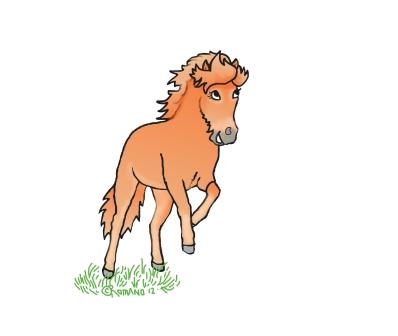
Home > Trip > Dispatches > Daily Dispatches > Local Dispatch #371
December 18, 2012: Input from a Guest Commentator
People continually surprise me, often in good ways. Yesterday, after posting the dispatch about the reviewer who refused to review the book, Pete went to the Amazon website, and discovered that Raudi’s Story had received two favorable reviews, one from my friend Heather, and another (I think) from Pam Nolf who is on the US Icelandic Horse Quarterly magazine editorial committee. In particular, Pam’s review was detailed, lengthy, and quite positive. I felt better after reading both, which was Pete’s intent. |
|
| Today I decided to ask Nancy Marie Brown, who is the editor of the Quarterly, to consider a review by Fran Bundtzen, who is the editor of the Alaska Icelandic Horse Association newsletter. She said yes, so Fran is going to email this on to her. I did this because Pete, Chris, and I have a great deal at stake here. Waiting until June for a favorable review to appear in this publication will cost in terms of time. We have to strike now, while the horseshoe iron is hot. I also told Chris Romano, the illustrator of Raudi’s Story, what had happened. She decided to write her own review and submit it to the Quarterly. It follows below. I do not know if Nancy Marie Brown will accept it. After all, she is one of the authors. But, well, stranger things have happened. I mean here we have a book that’s almost exclusively the point of view of a horse. What could be more farfetched than this? Certainly not a review by the text’s illustrator. . . . As I write this, I realize that we are dealing here with small peanuts. Raudi’s Story is probably not going to be on the New York Times Best-seller list. And the Quarterly’s audience is limited to Icelandic horse owners. However, I would not be writing a dispatch about a writing-related quandary if I was doing something else with my life, like say, being a Wal-Mart Greeter.
Creative Collaboration - How Two Icelandic Horse Fans Spent 2012. – by Chris Romano (your cartoonist) One of the amazing aspects of the USIHC is that, as a National Organization, members can interact in ways never imagined. That is what happened when Alys Culhane, who lives in Alaska, asked me to consider illustrating the book she was writing on the first five years of her mare, Raudhetta's life. I live in California and logistics alone presented a challenge to communication. However, with our experience contributing articles to the Quarterly, the challenge seemed do-able. After all, weren't we both devoted to the Icelandic Horse? We had another commonality; we both do horse expeditions. She’d taken her three Icelandic horses 500 miles down the Great Divide in 2011, and I’d packed into the Sierra Nevada’s with my Icelandic, though mine was a much a shorter trip. Anyone who has completed an expedition with horses, even if it's only days and not months, has to focus on being reliable, adaptive, self-motivated and organized. Facing and adapting to the elements, and doing what needs to be done, without being asked, that's want makes an expedition work. A book, especially one about our dear Icelandic horses, deserves no less effort and focus! I figured Alys and I could work together, simply because of our related wilderness and horse experience. Aly and I had also both read Temple Grandin's books on animal behavior, and the Icelandic author Haldor Laxness. Alys said, "It's a no brainer, we can work together, because of our love for the Icelandic Horse". None- the-less, we embarked on what amounted to months of work, with what’s usual in book publishing, little prospect of finding a publisher or any possibility of compensation. In the end we decided to self-publish Raudi’s Story as an e-book on Amazon and Smashwords. E-publishing requires dealing with a moving target, by that I mean the quickly changing formatting procedures for current e-publishing. As soon as I opened Aly's draft of Raudi's Story, I was hooked. I just had to illustrate this story written from her filly's point of view. I saw, too, that each horse in the story had a developed personality. And when the horses conversed, their conversations mirrored what we humans have observed in horse behavior. The human characters shone, as well. There was the loving Ben, who when Raudi is gravely ill from eating birdseed, stays in her stall for hours, singing to her. There’s also Katie Long, who runs a schooling stable, and tells Alys that she isn’t interested in what she has to say about training young horses. The book is dedicated to Katie, who now has advanced Alzheimer's disease. Alys sent me photos of some of the characters, and I tried to figure out how to show the various personalities involved. Showing Alaska was my next challenge, a place I've only visited via nature shows. It was important to select an aspect of each chapter that would enhance the story. The illustrations were drawn using the application, Corel Painter, an electronic drawing board and stylus all powered with an old Mac OSX. Fortunately, working on a computer allowed me to magnify what I'm drawing, and that made up for my limited eyesight. I began to send Alys drafts, and she provided me with feedback. Slowly, this story of a novice horsewoman tackling the challenges of learning to train a green horse became a reality. It all took place via emails, and it wouldn't have happened unless we had met through our years of volunteer work for the USIHC, It has certainly been a year well spent in devotion to the Icelandic horse. Both Alys and I hope that in the years to come that Raudi’s Story, An Icelandic Mare’s First Five Years of Life in Alaska will be enjoyed by many in the Icelandic horse community. |
|
